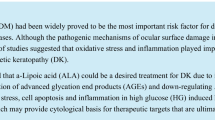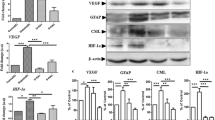Abstract
Delayed healing of corneal epithelial wounds is a serious complication in diabetes. Advanced glycation end products (AGEs) are intimately associated with the diabetic complications and are deleterious to the wound healing process. However, the effect of AGEs on corneal epithelial wound healing has not yet been evaluated. In the present study, we investigated the effect of AGE-modified bovine serum albumin (BSA) on corneal epithelial wound healing and its underlying mechanisms. Our data showed that AGE-BSA significantly increased the generation of intracellular ROS in telomerase-immortalized human corneal epithelial cells. However, the generation of intracellular ROS was completely inhibited by antioxidant N-acetylcysteine (NAC), anti-receptor of AGEs (RAGE) antibodies, or the inhibitor of NADPH oxidase. Moreover, AGE-BSA increased NADPH oxidase activity and protein expression of NADPH oxidase subunits, p22phox and Nox4, but anti-RAGE antibodies eliminated these effects. Furthermore, prevention of intracellular ROS generation using NAC or anti-RAGE antibodies rescued AGE-BSA-delayed epithelial wound healing in porcine corneal organ culture. In conclusion, our results demonstrated that AGE-BSA impaired corneal epithelial wound healing ex vivo. AGE-BSA increased intracellular ROS generation through NADPH oxidase activation, which accounted for the delayed corneal epithelial wound healing. These results may provide better insights for understanding the mechanism of delayed healing of corneal epithelial wounds in diabetes.




Similar content being viewed by others
References
Teodoro JS, Gomes AP, Varela AT, Duarte FV, Rolo AP, Palmeira CM (2013) Uncovering the beginning of diabetes: the cellular redox status and oxidative stress as starting players in hyperglycemic damage. Mol Cell Biochem 376:103–110
Xu KP, Li Y, Ljubimov AV, Yu FS (2009) High glucose suppresses epidermal growth factor receptor/phosphatidylinositol 3-kinase/Akt signaling pathway and attenuates corneal epithelial wound healing. Diabetes 58:1077–1085
Schulze SD, Sekundo W, Kroll P (2006) Autologous serum for the treatment of corneal epithelial abrasions in diabetic patients undergoing vitrectomy. Am J Ophthalmol 142:207–211
Mendez JD, Xie J, Aguilar-Hernandez M, Mendez-Valenzuela V (2010) Trends in advanced glycation end products research in diabetes mellitus and its complications. Mol Cell Biochem 341:33–41
Zhang X, Song Y, Han X, Feng L, Wang R, Zhang M, Zhu M, Jia X, Hu S (2013) Liquiritin attenuates advanced glycation end products-induced endothelial dysfunction via RAGE/NF-kappaB pathway in human umbilical vein endothelial cells. Mol Cell Biochem 374:191–201
Xue J, Rai V, Singer D, Chabierski S, Xie J, Reverdatto S, Burz DS, Schmidt AM, Hoffmann R, Shekhtman A (2011) Advanced glycation end product recognition by the receptor for AGEs. Structure 19:722–732
Luevano-Contreras C, Chapman-Novakofski K (2010) Dietary advanced glycation end products and aging. Nutrients 2:1247–1265
Zhu Y, Lan F, Wei J, Chong B, Chen P, Huynh L, Wong N, Liu Y (2011) Influence of dietary advanced glycation end products on wound healing in nondiabetic mice. J Food Sci 76:T5–T10
Kim J, Kim CS, Kim H, Jeong IH, Sohn E, Kim JS (2011) Protection against advanced glycation end products and oxidative stress during the development of diabetic keratopathy by KIOM-79. J Pharm Pharmacol 63:524–530
Zou C, Wang S, Huang F, Zhang YA (2012) Advanced glycation end products and ultrastructural changes in corneas of long-term streptozotocin-induced diabetic monkeys. Cornea 31:1455–1459
Gul M, Emre S, Esrefoglu M, Vard N (2008) Protective effects of melatonin and aminoguanidine on the cornea in streptozotocin-induced diabetic rats. Cornea 27:795–801
Niiya Y, Abumiya T, Yamagishi S, Takino J, Takeuchi M (2012) Advanced glycation end products increase permeability of brain microvascular endothelial cells through reactive oxygen species-induced vascular endothelial growth factor expression. J Stroke Cerebrovasc Dis 21:293–298
Bansal S, Siddarth M, Chawla D, Banerjee BD, Madhu SV, Tripathi AK (2012) Advanced glycation end products enhance reactive oxygen and nitrogen species generation in neutrophils in vitro. Mol Cell Biochem 361:289–296
auf dem Keller U, Kumin A, Braun S, Werner S (2006) Reactive oxygen species and their detoxification in healing skin wounds. J Investig Dermatol Symp Proc 11:106–111
Chien Y, Liao YW, Liu DM, Lin HL, Chen SJ, Chen HL, Peng CH, Liang CM, Mou CY, Chiou SH (2012) Corneal repair by human corneal keratocyte-reprogrammed iPSCs and amphiphatic carboxymethyl-hexanoyl chitosan hydrogel. Biomaterials 33:8003–8016
Shi L, Chang Y, Yang Y, Zhang Y, Yu FS, Wu X (2012) Activation of JNK signaling mediates connective tissue growth factor expression and scar formation in corneal wound healing. PLoS One 7:e32128
Ishibashi Y, Matsui T, Takeuchi M, Yamagishi S (2011) Rosuvastatin blocks advanced glycation end products-elicited reduction of macrophage cholesterol efflux by suppressing NADPH oxidase activity via inhibition of geranylgeranylation of Rac-1. Horm Metab Res 43:619–624
San Martin A, Foncea R, Laurindo FR, Ebensperger R, Griendling KK, Leighton F (2007) Nox1-based NADPH oxidase-derived superoxide is required for VSMC activation by advanced glycation end-products. Free Radical Biol Med 42:1671–1679
Octavia Y, Brunner-La Rocca HP, Moens AL (2012) NADPH oxidase-dependent oxidative stress in the failing heart: from pathogenic roles to therapeutic approach. Free Radical Biol Med 52:291–297
O’Brien WJ, Krema C, Heimann T, Zhao H (2006) Expression of NADPH oxidase in rabbit corneal epithelial and stromal cells in culture. Invest Ophthalmol Vis Sci 47:853–863
Kamioka M, Ishibashi T, Ohkawara H, Nagai R, Sugimoto K, Uekita H, Matsui T, Yamagishi S, Ando K, Sakamoto T, Sakamoto N, Takuwa Y, Wada I, Shiomi M, Maruyama Y, Takeishi Y (2011) Involvement of membrane type 1-matrix metalloproteinase (MT1-MMP) in RAGE activation signaling pathways. J Cell Physiol 226:1554–1563
Rodino-Janeiro BK, Gonzalez-Peteiro M, Ucieda-Somoza R, Gonzalez-Juanatey JR, Alvarez E (2010) Glycated albumin, a precursor of advanced glycation end-products, up-regulates NADPH oxidase and enhances oxidative stress in human endothelial cells: molecular correlate of diabetic vasculopathy. Diabetes Metab Res Rev 26:550–558
Piehl M, Gilotti A, Donovan A, DeGeorge G, Cerven D (2010) Novel cultured porcine corneal irritancy assay with reversibility endpoint. Toxicol In Vitro 24:231–239
Tie L, Yang HQ, An Y, Liu SQ, Han J, Xu Y, Hu M, Li WD, Chen AF, Lin ZB, Li XJ (2012) Ganoderma lucidum polysaccharide accelerates refractory wound healing by inhibition of mitochondrial oxidative stress in type 1 diabetes. Cell Physiol Biochem 29:583–594
Tie L, Li XJ, Wang X, Channon KM, Chen AF (2009) Endothelium-specific GTP cyclohydrolase I overexpression accelerates refractory wound healing by suppressing oxidative stress in diabetes. Am J Physiol Endocrinol Metab 296:E1423–E1429
Huo Y, Qiu WY, Pan Q, Yao YF, Xing K, Lou MF (2009) Reactive oxygen species (ROS) are essential mediators in epidermal growth factor (EGF)-stimulated corneal epithelial cell proliferation, adhesion, migration, and wound healing. Exp Eye Res 89:876–886
Roy S, Khanna S, Nallu K, Hunt TK, Sen CK (2006) Dermal wound healing is subject to redox control. Mol Ther 13:211–220
Acknowledgments
The authors thank Dr. Edward C. Mignot at the University of Shandong for linguistic advice. This work was supported by the Education Ministry Fund of China (No. 20070422081) and the Graduate Independent Innovation Foundation of Shandong University (No. 21300072613147).
Author information
Authors and Affiliations
Corresponding author
Additional information
Long Shi and Hongmei Chen contributed equally to this work.
Rights and permissions
About this article
Cite this article
Shi, L., Chen, H., Yu, X. et al. Advanced glycation end products delay corneal epithelial wound healing through reactive oxygen species generation. Mol Cell Biochem 383, 253–259 (2013). https://doi.org/10.1007/s11010-013-1773-9
Received:
Accepted:
Published:
Issue Date:
DOI: https://doi.org/10.1007/s11010-013-1773-9




